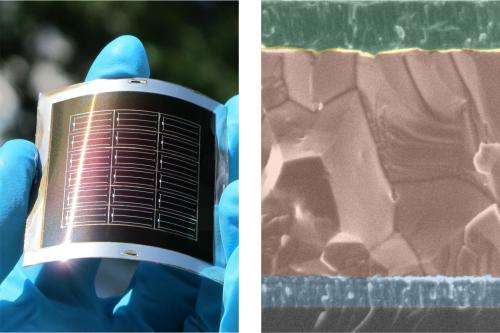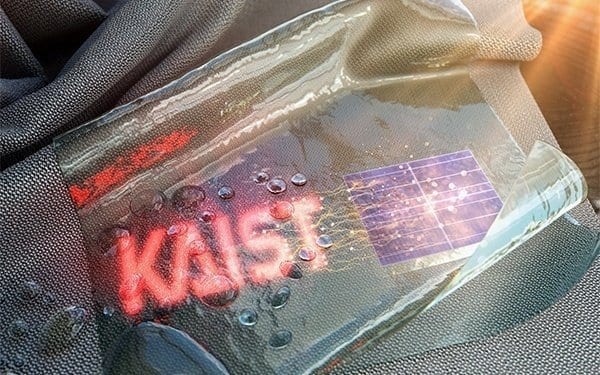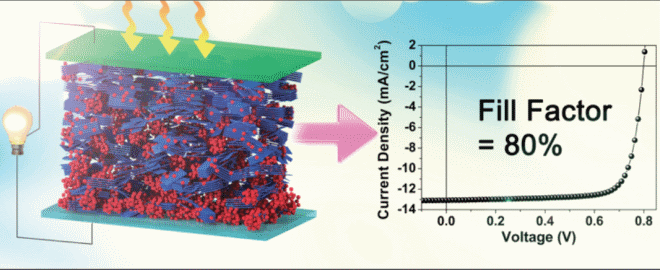
Flexible thin film solar cells that can be produced by roll-to-roll manufacturing are a highly promising route to cheap solar electricity.
Now scientists from Empa, the Swiss Federal Laboratories for Materials Science and Technology, have made significant progress in paving the way for the industrialization of flexible, light-weight and low-cost cadmium telluride (CdTe) solar cells on metal foils. They succeeded in increasing their efficiency from below eight to 11.5 percent by doping the cells with copper, as they report in the current issue of “Nature Communications”.
In order to make solar energy widely affordable scientists and engineers all over the world are looking for low-cost production technologies. Flexible thin film solar cells have a huge potential in this regard because they require only a minimum amount of materials and can be manufactured in large quantities by roll-to-roll processing. One such technology relies on cadmium telluride (CdTe) to convert sunlight into electricity. With a current market share that is second only to silicon-based solar cells CdTe cells already today are cheapest in terms of production costs. Grown mainly on rigid glass plates, these so-called superstrate cells have, however, one drawback: they require a transparent supporting material that lets sunlight pass through to reach the light-harvesting CdTe layer, thus limiting the choice of carriers to transparent materials.
The inversion of the solar cell’s multi-layer structure – the so-called substrate configuration – would allow further cost-cuttings by using flexible foils made of, say, metal as supporting material. Sunlight now enters the cell from the other side, without having to pass through the supporting substrate. The problem, though, is that CdTe cells in substrate configuration on metal foil thus far exhibited infamously low efficiencies well below eight percent – a modest comparison to the recently reported record efficiency of 19.6 percent for a lab-scale superstrate CdTe cell on glass. (Commercially available CdTe superstrate modules reach efficiencies of between 11 and 12 percent.)
Copper doping for solar cells
One way to increase the low energy conversion efficiency of substrate CdTe cells is p-type doping of the semiconductor layer with minute amounts of metals such as copper (Cu). This would lead to an increase in the density of “holes” (positive charge carriers) as well as their lifetimes, and thus result in a high photovoltaic power, the amount of sunlight that is turned into electrical energy. A perfect idea – if CdTe weren’t so notoriously hard to dope. “People have tried to dope CdTe cells in substrate configuration before but failed time and again”, explains Ayodhya Nath Tiwari, head of Empa’s laboratory for Thin Films and Photovoltaics.
His team decided to try nonetheless using high-vacuum Cu evaporation onto the CdTe layer with a subsequent heat treatment to allow the Cu atoms to penetrate into the CdTe. They soon realized that the amount of Cu had to be painstakingly controlled: if they used too little, the efficiency wouldn’t improve much; the very same happened if they “over-doped”.
The electronic properties improved significantly, however, when Lukas Kranz, a PhD student in Tiwari’s lab, together with Christina Gretener and Julian Perrenoud fine-tuned the amount of Cu evaporation so that a mono-atomic layer of Cu would be deposited on the CdTe. “Efficiencies increased dramatically, from just under one percent to above 12”, says Kranz. Their best value was 13.6 percent for a CdTe cell grown on glass; on metal foils Tiwari’s team reached efficiencies up to 11.5 percent.
The Latest Bing News on:
Solar cells
- Ground-Mounted Vs Roof-Mounted Solar Panels: Which Are Better?on April 27, 2024 at 9:15 am
Ground-mounted solar panels might be better for one home while roof-mounted solar panels are better for another. Here's how to decide between the two.
- How Many Solar Panels Does It Take To Power An RV/Motorhome?on April 26, 2024 at 11:15 pm
Solar power for RVs is taking off, so if you're looking to add some solar panels to your vehicle, it can take some math to figure out exactly what you need.
- Solar panel plant coming to eastern North Carolina with 900 jobson April 26, 2024 at 1:26 pm
A Vietnamese-based company will build its first North American solar panel manufacturing plant in eastern North Carolina, creating over 900 jobs.
- Researchers outline path forward for tandem solar cellson April 26, 2024 at 7:22 am
As the old saying goes, two heads are better than one. The same is true when it comes to solar cells working in tandem. Researchers at the U.S. Department of Energy's National Renewable Energy ...
- Solar panels in the eyes: reality or distant future?on April 26, 2024 at 4:44 am
Implanting tiny solar cells in people's eyes might sound like a futuristic idea, but it's what Australian scientists are exploring. This advanced technology could greatly help those with eye diseases.
- US solar panel makers seek import tariffs to protect new domestic factorieson April 25, 2024 at 1:20 pm
Some of the world's largest solar equipment makers on Wednesday asked President Joe Biden's administration to impose tariffs on panels and cells from four Asian countries to protect billions of ...
- Solar panels may prevent crop loss and regenerate clean energyon April 25, 2024 at 11:42 am
According to Derek Whitelock, agricultural engineer at the USDA ARS Cotton Ginning Research Laboratory in Las Cruces, NM, the United States needs more solar panels to produce renewable energy. Since a ...
- Key Solar Panel Ingredient Is Made in the U.S.A. Againon April 25, 2024 at 8:17 am
REC Silicon says it will soon start shipping polysilicon, which has come mostly from China, reviving a Washington State factory that shut down in 2019.
- New AD/CVD petition filed against solar cells and panels from Southeast Asiaon April 25, 2024 at 8:12 am
A new antidumping/countervailing duty petition has been filed with the U.S. International Trade Commission (USITC) and the Dept. of Commerce concerning ...
- Engineers uncover key to efficient and stable organic solar cellson April 25, 2024 at 7:56 am
A team of researchers led by Professor Philip C.Y. Chow from the Department of Mechanical Engineering at the University of Hong Kong (HKU) has made a significant breakthrough in the field of organic ...
The Latest Google Headlines on:
Solar cells
[google_news title=”” keyword=”solar cells” num_posts=”10″ blurb_length=”0″ show_thumb=”left”]
The Latest Bing News on:
Thin film solar cells
- How Do Solar Panels Work?on April 27, 2024 at 5:00 am
Find out how solar cells power a good portion of homes today—and how they might power virtually everything in the future.
- A look at freshwater usage in solar manufacturingon April 26, 2024 at 4:00 am
With solar power becoming more economical, quick to deploy and zero-emissions, it’s quickly emerged as a winner in the energy transition. As a result, ...
- Solar Panel Recycling Market worth $931 million by 2029 - Exclusive Report by MarketsandMarketson April 26, 2024 at 3:09 am
The report "Solar Panel Recycling Market by Type (Monocrystalline, Polycrystalline, Thin Film), Process (Thermal, Chemical, Mechanical, Laser, Combination) ...
- Solar Panel Recycling Market worth $931 million by 2029 - Exclusive Report by MarketsandMarkets™on April 26, 2024 at 3:00 am
Process (Thermal, Chemical, Mechanical, Laser, Combination), Shelf Life (Early Loss, Normal Loss), Material (Metal, Glass, Plastic, Silicone) - Global Forecast to 2029", is projected to reach USD 931 ...
- Key Solar Panel Ingredient Is Made in the U.S.A. Againon April 25, 2024 at 8:17 am
REC Silicon says it will soon start shipping polysilicon, which has come mostly from China, reviving a Washington State factory that shut down in 2019.
- Ultra-thin, flexible solar cells demonstrate their promise in a commercial quadcopter droneon April 24, 2024 at 9:27 am
Ultra-thin and flexible solar cells made from a new material called "perovskite" are proving to be an efficient and lightweight solution to facilitate self-sufficient energy generation over extended ...
- NREL updates interactive chart of solar cell efficiencyon April 24, 2024 at 8:44 am
The US National Renewable Energy Laboratory (NREL) has updated its research cell efficiency chart for a range of PV technologies.
- Photovoltaic Research Challenges: Overcoming Hurdles in Solar Technologyon April 24, 2024 at 7:44 am
Solar photovoltaic (PV) technology has evolved in the past few years, particularly in solar panels and systems. However, researchers and institutions are actively working to overcome limitations to ...
- Identifying what causes electron-hole separation in thin-film cells to increase solar cell efficiencyon April 21, 2024 at 5:00 pm
In particular, kesterite thin-film solar cells made of materials, such as copper, zinc, and tin, have the advantages of being balanced with resources and being cost-effective. Despite the research ...
- ZSW, First Solar partner to collaborate on thin-film PVon April 19, 2024 at 6:00 am
Württemberg (ZSW) and First Solar have agreed to work together to develop thin-film PV technologies on a gigawatt scale.
The Latest Google Headlines on:
Thin film solar cells
[google_news title=”” keyword=”thin film solar cells” num_posts=”10″ blurb_length=”0″ show_thumb=”left”]










